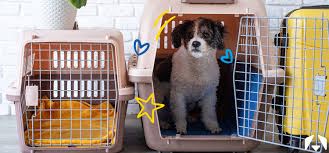
In this blog, we’ll show you how to crate train a puppy in a way that’s easy, kind, and effective. Bringing a new puppy home can also be a challenging process.
Crate training is one of the most powerful tools you have for raising a well-behaved and happy puppy. It might seem confining at first, but a crate can be a safe space for your puppy and an integral part of house training. So, let’s learn more about how to crate-train puppies.
What is Crate Training?
Crate training uses a crate (a small, enclosed space like a kennel or carrier) as a means to set boundaries, give your puppy a little safe space, and help them with house training. When correctly done, your puppy will see their crate as their den, and a place to relax and feel safe.
Why Crate Training is Important
Before we get into the specifics, let’s talk about why crate training is good for you and your puppy. Den animals by nature, dogs instinctively look for small, contained areas in which they can feel safe. A crate can replicate this safe space, allowing your puppy their little haven to chill out and decompress.
Crate training also helps:
Avoid accidents: It helps with potty training, teaching your puppy to wait until it’s time to go and hold their bladder.
Lower destructive-behavior: Puppies are inquisitive and can chew on furnishings or other items if you run away from them unattended. When you can’t keep an eye on them, the crate is a safe place.
Offer comfort and security: A crate is a safe spot for your puppy to go to for comfort, especially with traveling or if there are loud noises.
Step-by-Step Crate Training Process
Step 1: Choose the Right Crate
· Choose a crate size that is suitable for your puppy.
· It should be big enough for them to stand up and turn around and lie down comfortably, but not so big that they can call one corner their bathroom.
· Most crates have dividers that you can adjust as your puppy gets bigger.
Step 2: Create a Positive Association
· Set up the crate in a calm space in the home, like a living room, so your puppy can still be part of the family.
· Place soft bedding, some toys, or even an item with your scent (like an old t-shirt) to make it comfortable. To make them feel comfortable, keep the door open and invite your puppy to enter the crate himself.
· Sprinkle a couple of treats inside to lure them in. Welcome them in with cheer.
· Just be patient. This process can take hours or even days, depending on your puppy’s personality.
Step 3: Start Feeding Meals in the Crate
· Once your puppy is comfortable entering the crate, begin feeding their meals inside it. This reinforces positive associations and helps them view the crate as a pleasant place.
· Gradually close the door while they’re eating and open it as soon as they’re done.
· Over time, increase the duration that the door remains closed after meals.
Step 4: Practice Short Stays
· Once your pup is comfortable with the door closed, practice short stays:
· Show your puppy into the crate with a treat or toy Keep it closed and stay close for a few moments, opening the door back up later.
· Slowly lengthen the amount of time they stay in when you’re in the same room.
· When you finally do let them out, remember to praise or treat your furry friend for calm behavior.
Step 5: Leave the Room
· Once you’re confident your puppy is OK while you’re there, start leaving the room for short stretches.
· An excellent way to start is with just a few minutes, then increase to longer times.
· Don’t make a big deal when leaving or coming home it helps prevent separation anxiety.
· If your puppy whines or cries, don’t be tempted to let him out right away.
· Do not do this until they are calm, or you will reinforce the behavior.
Step 6: Use the Crate Overnight
· Gradually start using the crate as an overnight sleeping area when your puppy is ready:
· Put the crate next to your bed so they have the comfort of knowing you are close.
· Get them out for bathroom breaks as necessary throughout the night (puppies have tiny bladders!).
· If you prefer, gradually relocate the crate to its permanent location over time.
Conclusion
To conclude, if you are searching for how to crate train a puppy? I hope you will find its answer that crate training requires time and consistency, but it’s an invaluable tool in raising a well-adjusted, happy puppy.
By establishing positive associations with their carrier and working out these steps, you can put your pup in the best position for success while making life easier for you, the pet owner.
Just be patient and caring after this entire process. Before long, your puppy will think of their crate as the safe haven—a fort that no one can invade, a place that makes them feel safe and secure!

